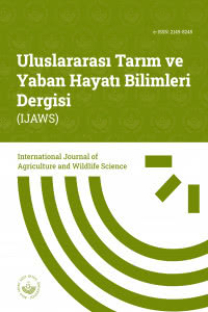Buğday ve Çeltikte Okratoksin A’nın Kantitatif Olarak Tespiti ve Validasyon Çalışması
Kontaminasyon, maksimum limit, mikotoksin
Quantitative Determination of Ochratoxin A in Wheat and Rice and Validation Study
Contamination, maximum limit, mycotoxin,
___
- AOAC. (2008). Official Method 2000.03. 2005 Ochratest and Ochratest WB Instruction Manual, 2008.
- Abdelhamid, A. M. (1990). Occurrence of some mycotoxins (Aflatoxin. ochratoxin A. Citrinin. zearalenone and vomitoxin) in various Egyptian feeds. Archives of Animal Nutrition, 40, 647-664.
- Abdel-Hafez, S. I. I., Moubasher Shoreit, A. H., & Ismail, M. A. (1990). Fungal flora associated with combine harvester wheat and sorghum dusts from Egypt. Journal of Basic Microbiology, 30, 467-479.
- Aydin, A., Aksu, H., & Gunsen, U. (2011). Mycotoxin levels and incidence of mould in Turkish rice. Environmental Monitoring and Assessment, 178, 271-280.
- Badr, A. N., Antonio, F. L., Hassan, A. A., & Taha, H. (2017). Ochratoxin a occurrence on Egyptian wheat during seasons (2009-2014). Asian Journal of Scientific Research, 10, 178-185.
- Buyukunal, S. K., Kahraman, T., & Ciftcioglu, G. R. (2010). Occurrence of AF. AFB1. OTA in rice commercialized in eastern Turkey. Polish Journal of Environmental Studies, 19, 907-912.
- Chauhan, R., Singh, J., Sachdev, T., Basu, T., & Malhotra, B. D. (2016). Recent advances in mycotoxins detection. Biosensors and Bioelectronics, 81, 532-545.
- De Koe, W. J., & Juodeikiene, G. (2012). Mycotoxin contamination of wheat, flour and bread. In S. P. Cauvain (Ed.), Breadmaking (pp. 614-618. Woodhead Publishing. EC. (2006). Commission regulation (EU) No 1881/2006 of 19 December 2006 setting maximum levels for certain contaminants in foodstuffs. Official Journal of the European Union, L364, 5-24.
- EC. (2012). Commission Regulation (EU) No 594/2012 of 5 July 2012 amending Regulation (EC) 1881/2006 as regards the maximum levels of the contaminants ochratoxin A. non dioxin-like PCBs and melamine in foodstuffs. Official Journal of the European Union, L176, 43-45.
- EFSA. (2004). Opinion of the scientific panel on contaminants in food chain on a request from the commission related to ochratoxin A (OTA) as undesirable substance in animal feed. EFSA Journal, 101,1-36.
- El Khoury, A., & Atoui, A. (2010). Ochratoxin A: General overview and actual molecular status. Toxins, 2, 461-493.
- El-Sayed, A. M. A. A., Soher, E. A., & Sahab, A. F. (2003). Occurrence of certain mycotoxins in corn and corn-based products and thermostability of fumonisin B1 during processing, Food/Nahrung, 47, 222-225.
- FAO/INFOODS. (2012) FAO/INFOODS Guidelines for Converting Units, Denominators and Expressions, version 1.0. FAO, Rome.
- Gareis, M. (2003). Collection of occurrence data of Fusarium toxins in food and assessment of dietary intake by the population of EU member states. Report of Experts Participating in SCOOP Task 3.2. 10-Part A: Trichothecene, 13-235.
- Gonzãlez, L., Juan, C., Soriano, J. M., Moltó, J. C., & Mañes, J. (2006). Occurrence and daily intake of ochratoxin A of organic and non-organic rice and rice products. International Journal of Food Microbiology, 107, 223-227.
- IARC. (1993). Monographs on the Evaluation of Carcinogenic Risks to Humans: Some Naturally Occurring Substances: Food İtems and Constituents. Heterocyclic Aromatic Amines and Mycotoxins. Vol. 56, International Agency of Research on Cancer, World Health Organization, Lyon.
- Juan, C., Zinedine, A., Idrissi, L., & Mañes, J. (2008). Ochratoxin A in rice on the Moroccan retail market. International Journal of Food Microbiology, 126, 83-85.
- Kara, G. N., Ozbey, F., & Kabak, B. (2015). Co-occurrence of aflatoxins and ochratoxin A in cereal flours commercialised in Turkey. Food Control, 54, 275-281.
- Levasseur-Garcia, C. (2018). Updated overview of infrared spectroscopy methods for detecting mycotoxins on cereals (corn. wheat and barley). Toxins, 10, 38.
- Lund, F., & Frisvad, J. C. (2003). Penicillium verrucosum in wheat and barley indicates presence of ochratoxin A. Journal of Applied Microbiology, 95, 1117-1123.
- Magan, N., Hope, R., Cairns, V., & Aldred, D. (2003). Post-harvest fungal ecology: impact of fungal growth and mycotoxin accumulation in stored grain. European Journal of Plant Pathology, 109, 723-730.
- Park, J. W., Choi, S. Y., Hwang, H. J., & Kim, Y. B. (2005). Fungal mycoflora and mycotoxins in Korean polished rice destined for human. International Journal of Food Microbiology, 103, 305-314.
- Ruscito, A., Mckenzie, S., Goundreau, D. N., & DeRosa, M. C. (2016). Current status and future prospects for aptamer-based mycotoxin detection. Journal of AOAC International, 99, 1-13.
- Saccon, F. A. M., Parcey, D., Paliwal, J., & Sherif, S. S. (2017). Assessment of Fusarium and deoxynivalenol using optical methods. Food and Bioprocess Technology, 10, 34-50.
- TGK. (2011). Gıdalardaki Mikotoksin Limitlerinin Resmi Kontrolü İçin Numune Alma, Numune Hazırlama ve Analiz Metodu Kriterleri Tebliği, Tebliğ No: 2011/32.
- TÜİK. (2017). Bitkisel üretim istatistikleri. http:/tuikapp.tuik.gov.tr/bitkiselapp/bitkisel.zul. Erişim tarihi: 12 Haziran 2017.
- Xu, L., Zhang, Z., Zhang, Q., & Li, P. (2016). Mycotoxin determination in foods using advanced sensors based on antibodies or aptamers, Toxins, 8, 1-16.
- ISSN: 2149-8245
- Yayın Aralığı: 3
- Başlangıç: 2015
- Yayıncı: BOLU ABANT İZZET BAYSAL ÜNİVERSİTESİ > ZİRAAT VE DOĞA BİLİMLERİ FAKÜLTESİ
Mücahit PAKSOY, Osman Doğan BULUT
Buğday ve Çeltikte Okratoksin A’nın Kantitatif Olarak Tespiti ve Validasyon Çalışması
Penny MEASHAM, Lynn Edwards LONG, Erdal AĞLAR, Clive KAİSER
Taşkesti (Mudurnu-Bolu) Beldesi Fındık PopülasyonununVerim ve Kalite Özelliklerinin Belirlenmesi
Maviyemiş Odun Çeliklerinde Köklenme Üzerine Alttan Isıtma Sıcaklığı ve Ortamların Etkisi
Tuba BEŞEN, Betül SAYIN, Mehmet Ali ÇELİKYURT, Musa KUZGUN, Şerife Gülden YILMAZ, Başak AYDIN, Melike BAHÇECİ
Türkiye'deki Bazı Doğa ve Kültürü Yapılan Yenebilir MantarlarınAntioksidan Enzim Aktiviteleri
